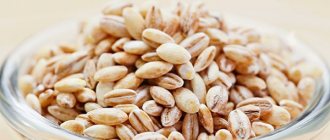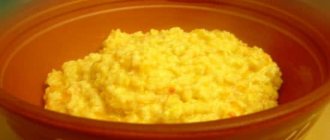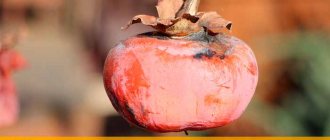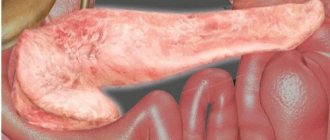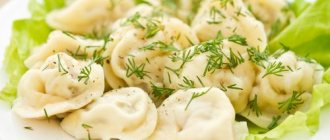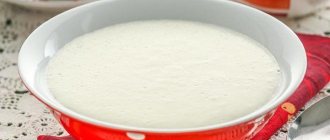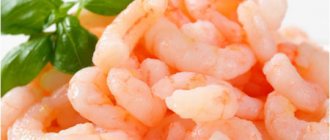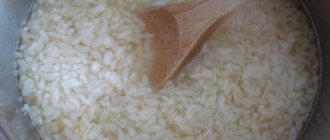Porridge is one of the main dishes on the menu for patients with pancreatitis. They appear in the diet already from 2–3 days after an attack of acute pancreatitis or an exacerbation of a chronic disease, and are subsequently present in the diet every day.
Porridges are nutritious and tasty, and if you follow the cooking instructions, they are well absorbed and digested without loading the pancreas. However, not all cereals are easily accepted during pancreatitis - some cereals are contraindicated or undesirable even during the period of remission.
Let's take a closer look at which porridges can and cannot be consumed during pancreatitis, how to prepare them correctly during different periods of the disease, and how, with the help of porridges, you can expand the range of dishes during remission.
“Forbidden” cereals
In case of exacerbation of pancreatitis, the following cereals are contraindicated:
- millet,
- corn,
- barley,
- wheat,
- legume porridge (peas, lentils, chickpeas).
Corn, millet porridge and legumes are also prohibited during periods of incomplete remission, and if there is persistent improvement, it is undesirable to consume them. If they do appear on the menu, it is very rare; they are introduced slowly, in small portions, well boiled. Barley and wheat porridge are allowed during remission, but not often.
What cereals can you eat?
Cereals allowed for consumption in both acute and chronic stages of the disease:
- polished rice;
- oats (oatmeal);
- semolina;
- buckwheat;
- pearl barley;
- linen;
- millet.
In the acute stage, before cooking, cereals should be ground into flour in a coffee grinder. It is convenient to grind cooked whole grain food in a blender. This is necessary to improve digestibility and absorption. Types of cereals that are strictly prohibited during exacerbation of pancreatitis:
- corn;
- barley;
- wheat
With stable remission, these mazanka porridges can be included in the diet from time to time. Barley, corn and wheat crops have a high content of carbohydrates, which makes the process of their digestion lengthy, as a result of which the load on the stomach and pancreas increases.
General features of eating cereals for pancreatitis
During an exacerbation, only approved cereals are allowed. The first one to appear on the menu is rice - it can be eaten on the 2-3rd day of treatment. During the first week, buckwheat, oatmeal, pearl barley and semolina porridge are also introduced.
During the acute phases of the disease, all porridges are cooked semi-liquid, with a viscous consistency. They should be cooked with water or half and half water with milk, without salt, sugar or butter. The porridge is cooked until completely boiled, and then pureed or blended with a blender until an almost homogeneous structure is obtained. If you have a coffee grinder or blender with a blade for solid foods, it is easier to first grind the cereal and then cook the liquid porridge.
During remission, when switching to a diet without mechanical sparing, porridge can and should be prepared without grinding (this preserves more valuable substances), including crumbly, with the addition of salt, sugar and a small amount of butter. With normal tolerance, porridge with milk is allowed without dilution with water.
What porridges are good for pancreatitis: corn, flax, semolina, buckwheat and wheat
For pancreatitis, the diet is filled with pureed soups, steamed meat and fish dishes, and, of course, porridge is recommended.
What will you have to give up?
For pancreatitis, millet porridge is classified as undesirable. It contains 60% carbohydrates. It is very difficult for the pancreas to digest millet polysaccharides. Although millet cereal itself is very useful for many other diseases. Delicious milk porridges are prepared from it or served with the addition of meat and fried onions.
So, for pancreatitis the following cereals are prohibited:
- millet;
- barley;
- pea;
- lentil;
- chickpea
Corn porridge
For chronic pancreatitis, when there is no exacerbation, this porridge can be prepared. The only thing is that it should not be used often. It is considered quite tough.
Recipe:
- You need to cook the cereal in water, or you can use skim milk.
- Bring to a boil over low heat and cook for about 20 minutes.
- Let it brew and steam the grains well.
During the period of exacerbation of the disease, do not consume corn porridge.
Buckwheat
A very healthy product, rich in vitamins, microelements and amino acids. In addition, buckwheat contains fiber and is rich in protein.
For pancreatitis, buckwheat porridge can be consumed if you follow simple rules. In stable remission, it is permissible to consume crumbly porridge. You can season with salt, butter, sugar.
It is allowed to serve as a side dish to stewed meat, steamed cutlets, etc.
Starting from day 5, it can be introduced into your diet. The porridge must be boiled well. Cook with half and half milk and water. You should not put salt, sugar and butter. From the third week you can introduce vegetable soup with buckwheat into your diet.
Cooking features:
- To get well-cooked porridge, you will need to cook it for a very long time.
- It will be more convenient to use buckwheat or flakes.
- It is necessary to carefully sort the cereal to separate the unrefined grains.
- The cooking process can be speeded up by soaking the cereal in water overnight.
Wheat porridge
For pancreatitis, prepare this porridge with a mixture of milk and water. This cereal is very rich in gluten and quickly gives you a feeling of fullness.
It is suitable for diversifying the patient’s menu, but it should not be prepared regularly.
Flaxseed porridge
What other products can relieve pancreatic tumors? It's not really porridge, it's a decoction of seeds. Its use for pancreatitis helps slow down cell division. The tumor is stabilizing.
Flaxseed porridge is recommended for patients with chronic pancreatitis to improve immunity. Flaxseed porridge contains mucus, which is resistant to acid and therefore the enveloping effect lasts a long time.
Recipe:
- To prepare this simple dish called flaxseed porridge, you need boiling water and flax seeds.
- Pour into a suitable container and let sit for a while, shaking occasionally.
- Take 1 spoon before meals.
What cereals help to “calm” the pancreas?
For pancreatitis, you can cook milk porridges, which are beneficial for the pancreas. In first place is rice. It does not irritate the walls of the gastrointestinal tract. It is an excellent absorbent and safely removes toxins. Milk rice porridges, puddings, and soufflés made from this cereal are easily digestible. You can prescribe porridge even during an exacerbation.
Milk rice porridges are cooked with the addition of water. The results are viscous, mucous, which envelop the stomach. Rice does not burden the pancreas and is easily digested. A source of complex carbohydrates that break down slowly and provide long-lasting energy.
Flaxseed porridge prevents constipation and cleanses the intestines of toxins. In addition, flaxseed porridge promotes healing and relieves inflammation.
Whatever porridge you prepare, it is important that it matches your diet, improves your well-being and does not cause aggravation. Try to diversify your daily diet, and it will not seem boring to you.
Author : Svetlana Nikolaevna Golubeva, especially for the site Zhkt.ru
-recipe for cooking buckwheat in water
Source: https://zhkt.ru/podzheludochnaya/pankreatit/pitanie/kashi.html
Features of different cereals
Rice porrige
Rice (unpolished) and porridges made from it have a lot of useful properties:
- rich in complex carbohydrates, providing a long-lasting feeling of satiety;
- are easily digested and do not create a burden on the diseased organ;
- do not irritate the pancreas and other parts of the gastrointestinal tract;
- rice is an excellent absorbent, absorbing and removing toxins from the intestines;
- Rice porridge envelops the walls of the gastrointestinal tract, protecting the mucous membrane from negative influences.
But it should be remembered that rice has a fixing effect, so it is not advisable to use it for constipation due to pancreatitis.
Oatmeal
Like rice, oatmeal is a mucous porridge that gently envelops the walls of the digestive tract; It is easily digestible and is rich in protein and easily digestible vegetable fat. The beneficial properties of oats include the ability to suppress aggressive pancreatic enzymes that support and trigger inflammation in the gland. Unlike rice, oatmeal stimulates intestinal motility and is indicated for constipation.
Semolina
Semolina porridge has the most delicate consistency, which makes it extremely convenient for use in the diet - there is no need for additional grinding of the cooked porridge. Semolina is easily digestible and quickly satisfies the feeling of hunger, does not irritate the mucous membranes of the stomach and intestines at all, does not burden the pancreas, and is an absolutely dietary product. But at the same time, semolina is relatively poor in vitamins and can cause constipation, so it is not suitable for daily use.
Buckwheat
Among all cereals, buckwheat has the richest vitamin and mineral composition and contains the most easily digestible vegetable protein, which makes it simply irreplaceable for patients with pancreatitis.
Barley porridge
Viscous pearl barley porridge is a mucous porridge that can envelop the walls of the gastrointestinal tract, protecting them from the action of the active components of digestive juices and other aggressive substances and at the same time absorbing toxins. But pearl barley is quite hard and requires thorough boiling followed by grinding for good absorption, especially during periods of exacerbations or incomplete remission.
Wheat and barley porridge
Wheat and barley cereals are rich in gluten and other complex carbohydrates, and therefore provide a long-lasting feeling of fullness. In addition, wheat and barley porridges are an excellent source of B vitamins. On the other hand, large amounts of carbohydrates are poorly absorbed against the background of pancreatitis and are subjectively difficult to tolerate for many patients (feeling of fullness in the stomach, nausea), so wheat and barley porridges are allowed only during time of remission and not too often.
Millet porridge
Millet polysaccharides against the background of pancreatitis are very poorly digested and can provoke an exacerbation, so porridge is included in the category of prohibited foods. But during remission of chronic pancreatitis, it can be included in the menu from time to time.
Corn porridge
Corn grits remain hard even after prolonged cooking and contain a lot of coarse fiber, and therefore its use in the diet of patients is extremely undesirable.
Bean porridge
All legumes are rich in coarse fiber, which causes bloating, pain and flatulence in pancreatitis. Therefore, porridges made from legumes are strictly prohibited, including during remission.
What are the benefits and harms of illness?
Rice grains are a source of useful microelements and a large amount of vitamins (B1-B9, E, PP, biotin, potassium, magnesium, phosphorus, silicon, manganese, cobalt and many others). These substances are vital for a person suffering from inflammation of the pancreas. With pancreatitis, they not only help improve the functioning of the digestive organs, but also have a beneficial effect on the general condition of the body, accelerating recovery.
Rice grains also contain a lot of protein, which is a kind of building material for cells and helps to quickly restore pancreatic tissue.
For pancreatitis, rice porridge provides the following benefits:
- due to the high content of complex carbohydrates, it satisfies the feeling of hunger for a long time and causes a surge of energy even when consuming small portions;
- easily digestible, without overloading the damaged organ, does not cause abdominal pain, bloating, nausea;
- helps reduce inflammation, having enveloping properties;
- helps remove harmful substances, mucus, fats from the intestines;
- eliminates diarrhea.
If rice porridge is prepared correctly and consumed in moderation, it will not cause any harm to the body of a person suffering from pancreatitis. Dish ingredients such as sugar, butter and full-fat milk can negatively affect the digestive system and increase the symptoms of pathology. You also need to remember that rice porridge is not recommended for those who suffer from constipation due to inflammation of the pancreas, since the product helps to consolidate the stool and can aggravate the delay in defecation.
Brown rice is not polished, contains too much fiber and is not suitable for dietary nutrition due to its ability to irritate the mucous membrane of the digestive organs.
Porridge is delicious!
Many people do not like porridge since childhood, considering them, although healthy, but not very tasty food. Of course, with an exacerbation of pancreatitis, viscous pureed unsweetened porridge without oil can hardly be called a masterpiece of culinary art, they quickly get boring, and patients eat porridge extremely reluctantly.
But during the period of remission, they can be prepared in such a way that the porridge will become a real feast of taste even for gourmets and can significantly diversify the usual diet. How to do it?
The following ingredients can add flavor to the porridge, and often dramatically change it, making it completely unrecognizable:
- Butter, sugar, jam or honey - it is quite acceptable to consume them during remission.
- Fresh or frozen berries (strawberries, blueberries, etc.) - add them before removing the porridge from the stove, stir and let it brew under the lid.
- Fresh fruits - pieces of banana, peach, apple, apricot go well with milk porridges.
- Pumpkin is a great addition to milk rice porridge; you can also cook oatmeal with pumpkin. To prepare milk porridge with pumpkin, boil the cereal in milk, and the pumpkin pieces separately in water until soft. 2-3 minutes before readiness, add pumpkin to the porridge and stir.
- Raisins - rinse them and pour boiling water over them, and then add to the porridge.
- You can sprinkle the porridge with crushed nuts or a small amount of seeds.
Methods for preparing porridge
The taste, appearance and consistency of porridge largely depend on the cooking methods. Try not to cook porridge on the stove, but cook it in a pot, where the cereal becomes soft and boiled over a long period of simmering, but at the same time retains most of the vitamins and valuable substances. Very tasty, crumbly, dairy-free and boiled milk porridges are made in a slow cooker and pressure cooker.
Also, do not forget that porridges can be not only dairy-based - crumbly porridges (rice, buckwheat, pearl barley) can be served as a side dish with meat, poultry or fish, with stewed vegetables, herbs, gravy and other sauces. In addition, different cereals can be cooked at the same time - wheat and rice, oat and wheat cereals, rice and oatmeal go well together.
Rules for eating
Cereal dishes are indispensable for people suffering from diseases of the digestive tract and form the basis of therapeutic and dietary nutrition. Unpolished brown rice, as well as wild and black rice, contains and retains a complete set of microelements after heat treatment, but these varieties are included in the menu with the permission of a doctor.
When introducing white polished grains into a patient's diet, the stage of pancreatitis should be taken into account. Both the consistency and composition of the porridge depend on this.
General rule: rice dishes are included in the menu no more than 2-3 times a week.
In acute form
In the menu of a person who has suffered an acute stage of the disease, porridge is introduced immediately after the drinking regime - at the very beginning of enteral nutrition (2-3 days). Polished cereals are suitable for dishes; such grains are not saturated with vitamins and minerals, but they are more tender than other varieties and boil well.
Unpolished brown rice, as well as wild and black rice, contains and retains a complete set of microelements after heat treatment, but these varieties are included in the menu with the permission of a doctor.
First, dietary porridge is prepared without salt, sugar and milk. To achieve the most liquid consistency, it is ground and diluted with water. A few days later, the same liquid dish is prepared, but with the addition of skim milk diluted with water.
The volume of portions is increased gradually, bringing it from 50 g to 200 g over the course of a month.
In the chronic stage
A gentle diet is maintained during the chronic course of the disease, but the patient can already add salt and butter to rice porridge cooked with whole milk.
It is allowed to include both crumbly and viscous porridges in the diet (there is no need to grind them).
During exacerbation of the disease
During an exacerbation of a chronic disease, rice porridge is boiled in water and consumed in ground form until the signs of the inflammatory process disappear.
During remission
The patient’s body needs a large amount of minerals and other useful substances, and white polished grains cannot provide them in full. To compensate for the lack of nutritional components, honey, berries, and fruits are added to the dish. Dessert additives are chosen from among those allowed for pancreatitis. The porridge is cooked in whole milk, salt, sugar and butter are added to it.
To compensate for the lack of nutritional components, honey, berries, and fruits are added to the dish.
When a stable remission occurs (a period when no relapses of the disease were recorded for six months), you can include other varieties of cereals in the menu. They must be cooked for a long time.
Summary
Porridge for pancreatitis is an extremely healthy dish; it is recommended to eat it daily, at any meal (you can do it 2 times a day - different cereals). Each of the porridges has its own advantages, but to expand the diet and ensure adequate intake of all groups of vitamins and minerals, you need to alternate porridges from different cereals, using all possible methods of preparing them and approved additives.
Pediatrician and pediatric endocrinologist. Education: Faculty of Pediatrics, SSMU. I have been working since 2000, and since 2011 as a local pediatrician in a children's clinic. In 2021, I completed my specialization and received a certificate in pediatric endocrinology, and from the beginning of 2021 I have been additionally receiving appointments as…
Cereal porridges and their features
You can eat rice cereal immediately after fasting. Whole grain or ground into flour and boiled, this cereal, in addition to relieving irritation of the gastric mucosa, has fixing properties for diarrhea, which is often associated with gastrointestinal diseases.
You can start eating semolina porridge with a delicate consistency for pancreatitis on the 5-6th day of exacerbation. It saturates well and has excellent enveloping properties. Semolina porridge for pancreatitis should not be consumed more than twice a week.
Hercules Extra or finely ground oatmeal for pancreatitis is introduced into the diet immediately after the end of therapeutic fasting. It is useful to consume rolled oatmeal because of its properties that promote the effective removal of toxins from the patient’s body.
Important information: Effective treatment of pancreatitis with folk remedies and the most effective recipes
Buckwheat porridge for pancreatitis is cooked from finely divided buckwheat or ground into flour for better digestibility. This dish can be eaten with pancreatitis every day, regardless of the stage of the disease. Buckwheat is highly nutritious and contains a unique set of proteins, vitamins and minerals.
Flaxseed porridge for pancreatitis is not only a product, but also a medicine. Thanks to the unique properties of flax, foci of inflammation of the gastrointestinal mucosa are reduced and the likelihood of localizing new ones is minimized. In addition, flaxseed porridge is easily digestible and contains a range of useful vitamins and microelements.
Barley porridge for pancreatitis is allowed only during stable remission and is recommended for consumption no more than 2 times a week. Yachka is a rather difficult product to digest due to the large amount of carbohydrates it contains. We cook this cereal exclusively in water and eat it without adding butter or milk, even during stable remission.
Due to the coarse grinding and difficult digestibility, wheat porridge for pancreatitis, even when grinding the cereal into flour, is not very welcomed by doctors as a component of dietary nutrition.
Pearl barley or flour (this is how this product can be cooked) is not forbidden, but, on the contrary, is encouraged. To the question whether it is possible to eat pearl barley with this diagnosis, the answer is yes. Barley has the effect of removing toxins from the patient's body through their adsorption. Its enveloping properties help reduce irritation and inflammation of the mucous membrane.
Important information: How is nausea with pancreatitis treated?
Millet porridge has a reputation as a leader among cereals in terms of the content of microelements, vitamins and nutrients. Millet is hypoallergenic and ideal both as an independent food and as a side dish for a main meat dish.
Millet porridge should be somewhat limited in consumption due to its high starch content. Nutritionists have prescribed that after a month of eating, including millet, take a break for a decade. For cooking, you should buy a bright yellow product - this is a marker of the best vitamin and mineral composition of the cereal.
Comments
Tell me, can you eat porridge hot?
Hello! No, neither porridge nor other dishes can be eaten hot if you have pancreatitis. All dishes can only be eaten warm, the maximum temperature is approximately 50-60°C, that is, slightly hot.
Hello! Barley is ground pearl barley. Why is pearl barley on the list of allowed cereals? and barley is prohibited
To be able to leave comments, please register or log in to the site.
Those people who are faced with a disease such as pancreatitis know firsthand that in order to feel normal they need to adhere to a special diet.
The menu of people suffering from chronic inflammation of the pancreas consists of steamed fish and meat, soups and, of course, various cereals. Exactly what cereals can be eaten with pancreatitis and how they can be consumed will be described in this material.
Useful properties of cereals
Porridges included in the list of permitted foods for inflammation of the pancreas have an extremely beneficial effect on the body. Thanks to their viscous consistency, these cereal dishes gently and effectively envelop the tissues of the digestive organs, suppressing the negative effects of aggressive enzymes.
There are certain types of porridges that can be used both during periods of stable remission and in the acute stage of pancreatic diseases. During exacerbation of pancreatitis, patients are often prescribed a regime of complete fasting, subject to which the consumption of any foods is excluded. It is only permissible to drink purified water. As a rule, therapeutic fasting of this kind is carried out for at least two to three days, until the patient’s condition is relatively stabilized.
Corn
When consuming this porridge for chronic pancreatitis, it is necessary to take into account some features. The first limitation is the frequency of use of this product. It should not be eaten often due to the fact that corn has hard fibers. The second aspect is the cooking process. It should be prepared with low-fat milk or water.
The recipe for making such a delicacy is extremely simple. Corn grits must be boiled using water or low-fat milk for about twenty minutes. After this, you need to wrap the pan with a towel and wait until it steams. During an exacerbation of inflammation of the pancreas, corn porridge should be avoided.
Buckwheat
Nutritionists advise adding buckwheat to the diet for people with chronic inflammation of the pancreas.
Buckwheat is excellent as a product that is useful for inflammation of the pancreas.
Buckwheat can rightfully occupy a leading position in composition among other competitors. It contains a huge amount of healthy vegetable protein and a unique set of amino acids. Such cereals can almost completely help replace the consumption of meat products, if necessary.
The specificity of the diet for chronic pancreatitis is due to a decrease in the amount of carbohydrates. Therefore, buckwheat can take a leading place in the patient’s diet. Buckwheat also contains a large amount of fiber. It helps normalize digestion and helps cleanse the intestines.
The use of buckwheat porridge for pancreatitis is allowed from the fifth day after the prescription of a therapeutic diet. But not before the patient’s pain is relieved.
It can be consumed during an acute inflammatory process in the following form: after preparing heavily boiled cereal, it must be thoroughly wiped. It should be eaten without adding oil, spices, sugar and salt.
It is important to know that you should not eat buckwheat every day. The diet can be diluted with other cereals.
During chronic pancreatitis, the preparation of crumbly cereal is allowed. You can add salt and oil, both vegetable and butter, to it.
It is worth remembering that porridges for chronic pancreatitis should not contain mushrooms and fried vegetables.
Rice diet and its benefits
As many years of practice have shown, eating rice for pancreatitis will quickly and effectively improve the functioning of the digestive organs. The reason is the composition of rice grains, which contain a maximum of carbohydrates, which give the body additional energy for work and relieve hunger for a long time.
Benefits of the rice diet:
- A simple rice porridge or soup can work wonders of medicine in a sore stomach. Thanks to their viscous consistency, both dishes coat the mucous cavities, forcing the pancreas to work properly. As a result, digestion is easier and faster, the risk of diarrhea is reduced, and the stomach begins to absorb food normally again, without unpleasant consequences.
- Rice is quickly digested and well absorbed by the body; eating cereal will hardly put any strain on the affected pancreas.
- Due to its sorbing ability, cereal absorbs toxins, which greatly complicate the normal passage of the digestive process.
It is important not to get carried away with the rice diet, consume in small portions, soon the patient will feel pleasant changes in the body. The danger of constipation present with such a diet can be easily eliminated by including vegetable dishes and fresh fruits in the daily menu.
Rice in the treatment of acute pancreatitis
The first signs of acute pancreatitis appear in patients who have suffered an attack of the disease. The attack is accompanied by acute, sometimes unbearable pain in the abdominal area, the source of which is the inflamed pancreas.
After such an attack, the patient is allowed to eat normal food after two to three days. First drink, then liquid rice porridge with water and milk without butter, salt and sugar is added to the diet. After a couple of days, rice soup appears. By the end of the first month of treatment, the patient has the right to choose pudding or rice meatballs.
Polished rice is used to prepare dishes. Cereals boil faster and are absorbed by the body better than other varieties. Eating rice during pancreatitis, especially in the acute stage, is useful due to its sorbing properties and “calming” effect on the mucous membranes of the stomach.
If the patient has chronic pancreatitis
When the chronic stage of pancreatitis occurs with characteristic signs of exocrine and endocrine insufficiency, careful monitoring of nutrition is required. Rice remains part of the list of a few products recommended for the patient, which continue to have a positive effect on the gastrointestinal tract in conditions of exacerbation of the disease.
To diversify the rice diet and saturate the food with vitamins, proteins and microelements, it is allowed to consume the cereal in combination with boiled or stewed vegetables. You can use rice as a side dish for fish, lean meat, adding a little vegetable oil/butter or kefir to the dish. You should not exclude the usual rice porridge with milk and cereal soup from your diet. Casseroles, puddings, and vegetables stuffed with rice are useful for chronic pancreatitis.
At this stage of the disease, polished grains can easily be replaced with steamed rice, which is quite suitable for preparing a side dish. The cereal needs to be cooked longer until soft.
It is recommended to avoid frequent consumption of rice dishes during remission of chronic pancreatitis. Every body needs a large range of nutrients, which white rice is poor in. The rice diet partially complicates bowel function, leading to frequent constipation. Brown rice, unlike white rice, retains selected microelements during heat treatment, however, the use of this grain is extremely rare in case of stable, confident remission.
Wheat
It requires caution when used during pancreatitis. Coarse grinding can cause discomfort or even pain in the patient. To avoid this, wheat porridge for pancreatitis should be added to the diet no earlier than 5-6 days. This cereal must be prepared without adding spices, salt and oil. Experts allow the use of this porridge even during an exacerbation, but it is better not to risk it and consume it no more than 2 times a week during a stable remission.
What cereals are allowed
In order to avoid worsening the condition of patients with pancreatitis, as well as other diseases of the pancreas of inflammatory pathogenesis, it is necessary to know which types of cereals can be included in the diet, and which should be excluded, or eaten in limited quantities. The following types of cereals are allowed for consumption:
- Rice. This is one of the first porridges that should be included in the patient’s diet immediately after completing the fasting regime. It should be eaten without oil, salt, or other additives that improve the taste. You should cook it exclusively with water, after grinding the cereal into a kind of powder. Rice in any form is perfectly digestible and keeps you feeling full for a long time, despite its low calorie content. The viscous consistency of this porridge allows it to gently envelop the walls of the stomach, preventing tissue irritation. In addition, the dish has a pronounced fixing effect, which is important when diarrhea occurs against the background of acute pancreatitis.
- Manna. Semolina is carefully ground grains of ordinary wheat. Semolina has a delicate and dense consistency, it saturates perfectly without overloading the digestive tract. It can be introduced into the diet during the acute stage, but this should be done no earlier than the fifth day. It is also not recommended to overuse porridge, which uses semolina as the main ingredient. The optimal amount is no more than one serving twice a week.
- Barley for pancreatitis is not a prohibited dish. This porridge actively protects the mucous tissues of the digestive organs from the negative effects of secretions produced in the tissues of the pancreas, and also, through absorption, promotes the removal of various breakdown products from the body.
- Carefully ground buckwheat, as well as semolina, perfectly saturates the body with essential substances and also gives a feeling of fullness for a long time. Both in the acute stage and during the period of remission, you can eat buckwheat daily, since this dish is an irreplaceable source of vitamin complexes, proteins and minerals.
- Linen. Flaxseed is one of the unique products that can be used not only as a food product, but also as a medicine. Regular consumption of such a dish for any diseases of the digestive tract allows you to effectively reduce the source of inflammation in a short time, relieve unpleasant symptoms, and also prevent their further manifestation. Also, unlike cereals such as semolina and millet, flax seeds are perfectly digestible, without requiring a colossal load on the body during the digestion process.
- Oatmeal. Oatmeal porridge is also recommended as the first dish to be offered to patients after a course of fasting. To make it easier for the body to digest it and absorb the necessary substances, it needs to be ground into flour before cooking. The dish not only satisfies perfectly, but also promotes the effective removal of toxins.
For diseases of the pancreas, it is necessary to carefully monitor the composition of the daily menu. Regardless of which foods are included in the patient’s diet, together they should provide him with the amount of nutrients necessary for the normal functioning of the body.
Oatmeal
Oatmeal for pancreatitis is one of the main products. It can rightfully be considered an important separate dish in a therapeutic diet. Oats are a grain that is number one in vitamin B1. A distinctive feature of oatmeal is the fact that it contains a substance such as serotonin. This hormone is designed to improve your mood, and the energy gained from eating oatmeal can last you the whole day.
Oatmeal helps the body absorb fats and carbohydrates. This is due to the fact that it contains enzymes that are similar to the enzymes produced by the pancreas. It is precisely this fact that makes oatmeal so necessary in a therapeutic diet for inflammation of the pancreas.
Also, consuming this product helps stabilize blood cholesterol levels.
When eating oatmeal during pancreatitis, it is necessary to take into account some features. It contains a large amount of fiber, which does not allow it to be added to the patient’s menu during an exacerbation of inflammatory processes in the pancreas.
Experts recommend cooking oatmeal in water. If the patient experiences any negative sensations after consuming it, then such a product should be discarded.
During remission, it is allowed to add a small amount of butter and sugar to it.
Cereal dishes
Porridges for pancreatitis, as a component of nutrition, are perfectly satiating and have a beneficial effect on the functioning of the gastrointestinal tract. Thanks to the enveloping consistency, porridge does not provoke an increased secretion of digestive juices, thereby giving rest to the irritated pancreas and other digestive organs.
Some types of cereals can be eaten at any stage of inflammation of the pancreas, others - only in a state of remission. They are cooked strictly in water only during the acute stage of the disease; if the condition is consistently good, cooking with milk is permissible. Milk can be added to the finished product, as can a small amount of butter or dried fruit, but salt should be limited. Cereal dishes can be eaten not only as independent dishes, but also as side dishes for meat and vegetable foods.
Important information: Chronic pancreatitis of the pancreas on ultrasound
Menu for pancreatitis for a week
Our readers successfully use Monastic Tea to treat gastritis and ulcers. Seeing how popular this product is, we decided to bring it to your attention. Read more here...
Pancreatitis is inflammation of the pancreas. With this disease, it is necessary to adhere to dietary nutrition, regardless of the form in which it occurs. First of all, it is important to know that the menu for pancreatitis for a week is selected purely individually. What is prohibited to be consumed during an exacerbation is allowed during the remission stage.
For chronic pancreatitis, the diet consists of consuming food with minimal acidity and spices. All dishes are prepared exclusively with water or steam. If it occurs in an acute form, during the first 24 hours the patient drinks only clean water. So, he should consume two liters of water per day. After a few days, liquid soups, cereals, and purees are allowed.
How long to follow the diet?
This question interests almost every patient with pancreatitis. As a rule, a menu for a week for pancreatitis is drawn up. But you need to follow a diet, especially in advanced cases, almost constantly. You will have to eat dishes boiled, baked or cooked in a double boiler. You need to give up fried, salty, pickled, smoked and alcoholic drinks forever, so as not to worsen your condition.
List of permitted products:
- chicken, turkey, rabbit, veal meat. You can make meatballs, cutlets from them, or cook them in portions;
- fish. Steam or bake in foil;
- omelette. If you want a boiled egg, it should be soft-boiled;
- pasta only in the form of soups. Porridge is prepared from buckwheat, semolina, rice and oatmeal;
- Ryazhenka, kefir, low-calorie yogurt.
The menu should include only white bread, which must be dried in the microwave in advance. In fresh form, it is prohibited.
This is what the menu looks like
- Breakfast: oatmeal with water (if there are no contraindications, you can have milk). You can add a little honey for taste;
- Lunch: vegetable soup without cabbage, steamed fish;
- Dinner: chicken breast with stewed carrots or zucchini.
